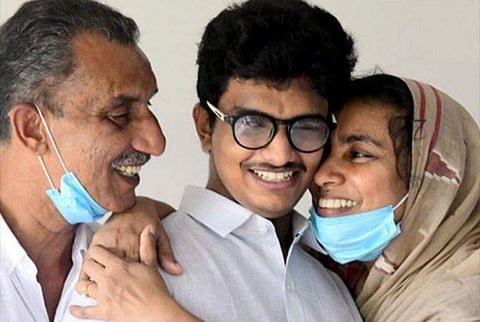

Haroon Kareem TK is the first student in Kerala to write his 10th standard SSLC examination on a computer. To do this, the 15-year-old from Melattur in Malappuram, who has been visually impaired since birth, spent his entire academic life fighting the education system and the limitations of technology to study the subjects that he loved most. Although his parents were confused about how to help him, his mother, being a teacher herself. found him a place in a special school. Haroon's account of life in a special school is unlike any of the rosy stories we have heard so far. He says, "When I was three, I used to make my sisters read to me. This stopped when I was admitted to a special school. Until the 7th standard, I had only read a total of eight books because only those were available in Braille! It's a special world of its own with nothing outside it. It is just unacceptable to me. They are not ready to focus on Math or Science. Even if it's in the Kerala syllabus, they only teach Social Science or Arts and do not even finish the lessons. Don't we also deserve a choice of subjects?"
In the 5th standard, his parents gifted him his first computer. On this, he taught himself how to use the internet, installed a screen reader, an assistive technology that renders text and image as speech or Braille. At the age of 11, he learnt to read books using the technology. As the school's hostel did not allow technology, he moved back home where he attempted to learn the whole of Wikipedia by rote. During his summer vacation in the 7th standard, Haroon attended a programme in Chennai organised by Chakshushmati, an organisation that works for the welfare of the blind. Managing Trustee of the organisation, Professor Ram Kamal was the first person to speak the same language as Haroon. "He introduced me to everything I believe in. Although he has sight himself, he was the first person who fully understood the issues of studying in a special school. We spoke for six and a half hours that day. At the end, I realised that mastering my computer could change the way I was learning," recalls Haroon.
In the 8th standard, Haroon shifted to Mankada Government Higher Secondary School. He had discovered Bookshare, an online library for the print disabled. Having learnt more about his options, he still found himself unsatisfied with his school life. "On my first day of school, I participated in a quiz competition where a scribe noted down my answers. I won the first prize but had to watch the same scribe collect my award and garner all the appreciation. No one asked or cared about the work I was doing, I felt unchallenged."
Since he had already trained himself in typing, Haroon requested the Headmistress if he could use his computer for schoolwork, which she agreed to. On his first day of school with a computer, he printed his test answers for a teacher who was shocked and excited about what he had managed to do. That was a major turning point for Haroon. In the 9th standard, he could read and write Malayalam on his computer using the Optical Character Resolution technology, which he had altered enough for his purpose.
But he faced one last barrier by the time he reached the 10th standard: Microsoft Word did not support writing Maths and Science. "Math accessibility in the visually impaired world is still a distant dream. Everything from equations to diagrams is lost between this divide," says Haroon, "So I taught myself programming with the help of a few existing open source softwares. When I learnt how to code, I tweaked the system into enabling these subjects. My public exams were approaching and I needed a solution. I found a software called the INFTY Editor, which is actually intended for people with sight. Originally, it did not support a common language called Mathematical Markup Language (MathML), so I decided to alter that a bit." After Haroon worked on it, the INFTY Editor could write any mathematical equation. Although it did not support diagrams, it could be entered in the exams with the support of a scribe.
Having paved his own path along every juncture, Haroon was finally ready for his final battle. To allow him to write his exam on a computer, his school sent a request to the education ministry. On February 14, the morning of his first model exam, he was greeted with the news that he would not be allowed to write the exam on a system. After a few calls were made, Haroon found himself studying outside of the Secretariat on the day before his exams while his parents were filling form after form to secure permission. He returned to his school the very next morning with a permitting order. He says, "What I will never forget is being able to write the exam in my own words for once." Haroon's results came back with an A+ on all ten of the subjects that he had attempted. For the next year, he plans to move to The White School International in Kozhikode, an International Baccalaureate Board School. And what's next on his list of challenges? He wants to study at Stanford University and become a software engineer.
